Taxation Law Analysis
VerifiedAdded on 2020/03/23
|14
|2624
|83
Report
AI Summary
This report provides a comprehensive analysis of various taxation law issues, including the application of the ITAA 1997, fringe benefits tax, and joint ownership in rental properties. It discusses relevant laws, issues, and applications, supported by case studies and rulings. The report concludes w...
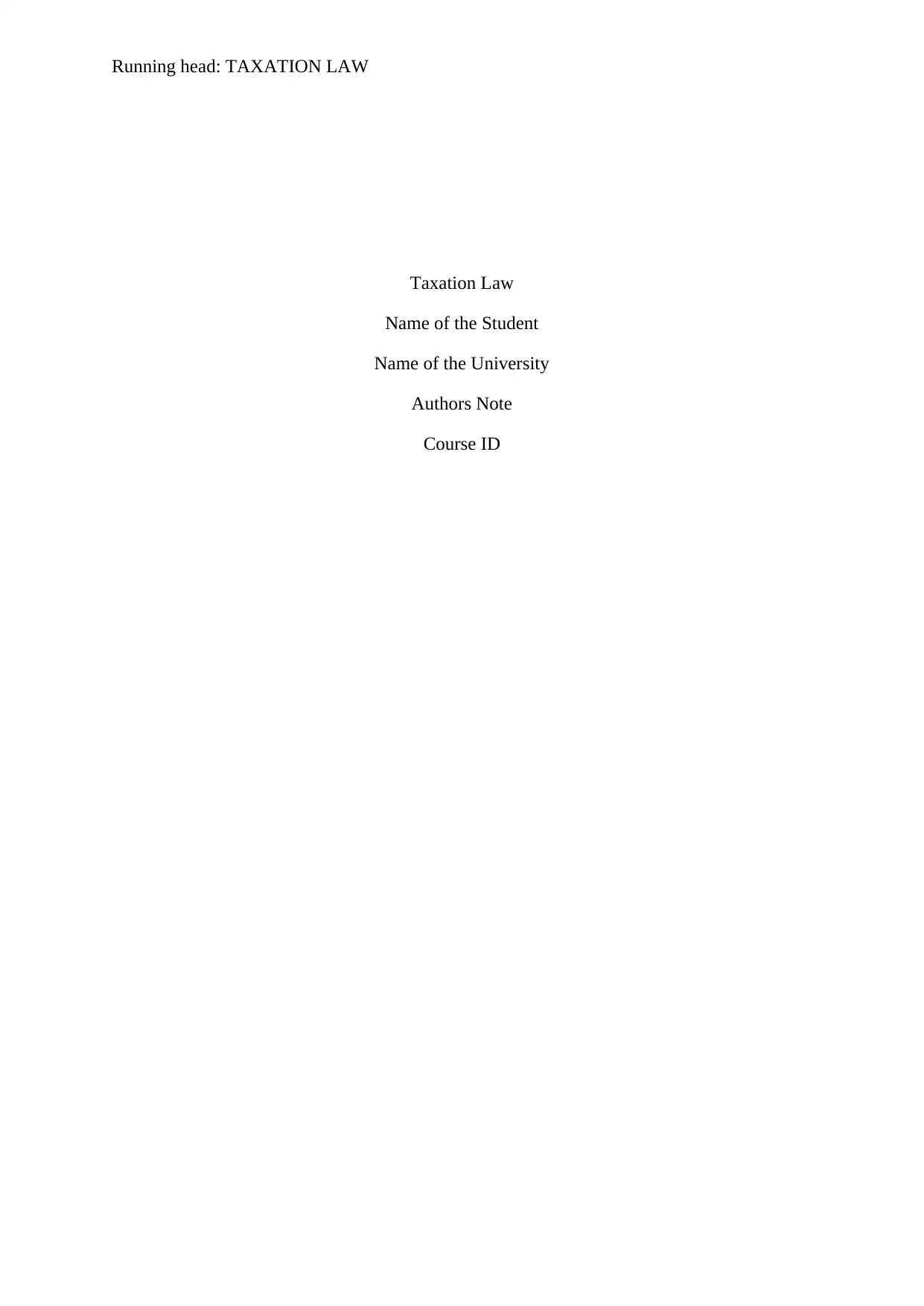
Running head: TAXATION LAW
Taxation Law
Name of the Student
Name of the University
Authors Note
Course ID
Taxation Law
Name of the Student
Name of the University
Authors Note
Course ID
Paraphrase This Document
Need a fresh take? Get an instant paraphrase of this document with our AI Paraphraser
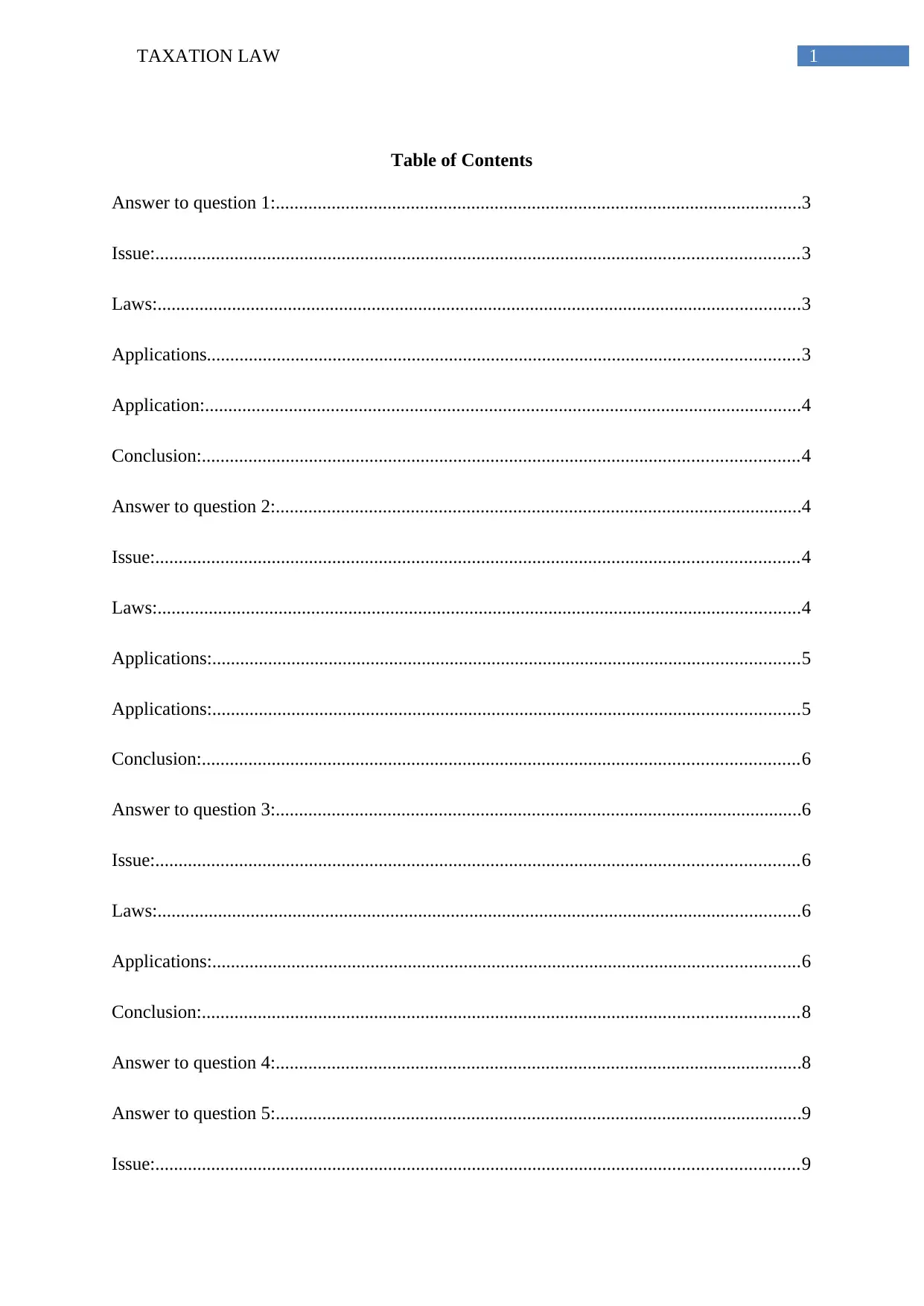
1TAXATION LAW
Table of Contents
Answer to question 1:.................................................................................................................3
Issue:..........................................................................................................................................3
Laws:..........................................................................................................................................3
Applications...............................................................................................................................3
Application:................................................................................................................................4
Conclusion:................................................................................................................................4
Answer to question 2:.................................................................................................................4
Issue:..........................................................................................................................................4
Laws:..........................................................................................................................................4
Applications:..............................................................................................................................5
Applications:..............................................................................................................................5
Conclusion:................................................................................................................................6
Answer to question 3:.................................................................................................................6
Issue:..........................................................................................................................................6
Laws:..........................................................................................................................................6
Applications:..............................................................................................................................6
Conclusion:................................................................................................................................8
Answer to question 4:.................................................................................................................8
Answer to question 5:.................................................................................................................9
Issue:..........................................................................................................................................9
Table of Contents
Answer to question 1:.................................................................................................................3
Issue:..........................................................................................................................................3
Laws:..........................................................................................................................................3
Applications...............................................................................................................................3
Application:................................................................................................................................4
Conclusion:................................................................................................................................4
Answer to question 2:.................................................................................................................4
Issue:..........................................................................................................................................4
Laws:..........................................................................................................................................4
Applications:..............................................................................................................................5
Applications:..............................................................................................................................5
Conclusion:................................................................................................................................6
Answer to question 3:.................................................................................................................6
Issue:..........................................................................................................................................6
Laws:..........................................................................................................................................6
Applications:..............................................................................................................................6
Conclusion:................................................................................................................................8
Answer to question 4:.................................................................................................................8
Answer to question 5:.................................................................................................................9
Issue:..........................................................................................................................................9
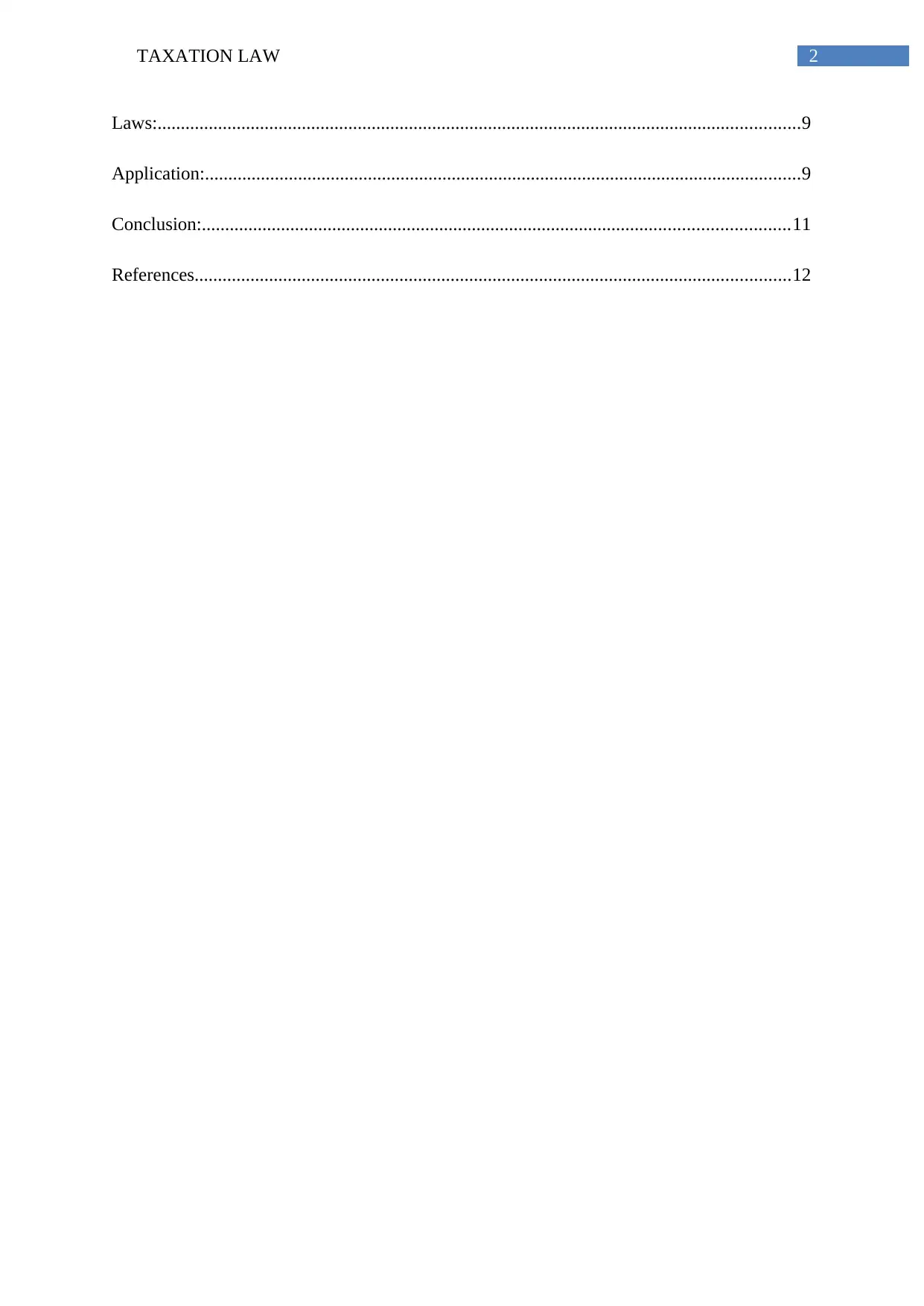
2TAXATION LAW
Laws:..........................................................................................................................................9
Application:................................................................................................................................9
Conclusion:..............................................................................................................................11
References................................................................................................................................12
Laws:..........................................................................................................................................9
Application:................................................................................................................................9
Conclusion:..............................................................................................................................11
References................................................................................................................................12
⊘ This is a preview!⊘
Do you want full access?
Subscribe today to unlock all pages.

Trusted by 1+ million students worldwide
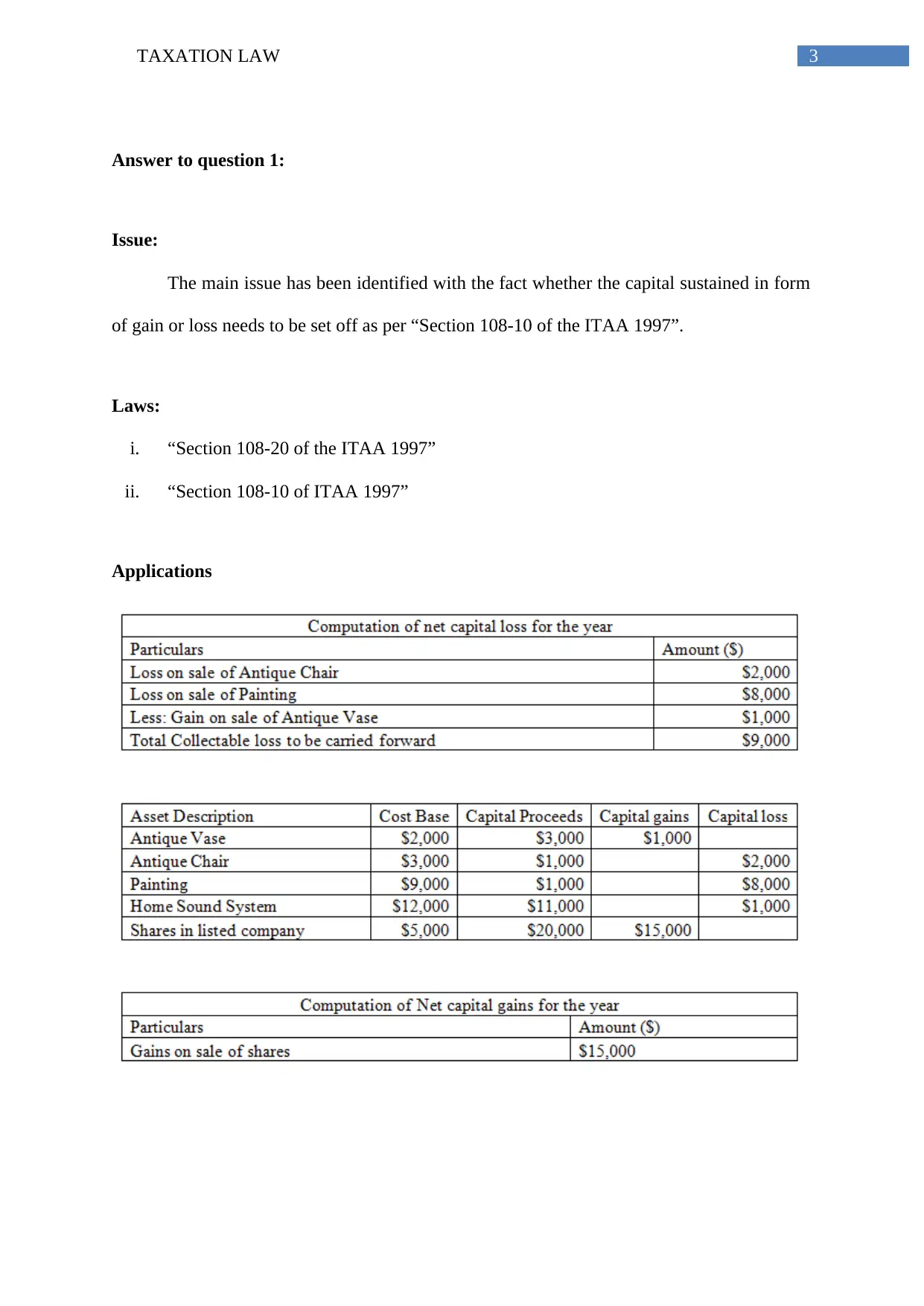
3TAXATION LAW
Answer to question 1:
Issue:
The main issue has been identified with the fact whether the capital sustained in form
of gain or loss needs to be set off as per “Section 108-10 of the ITAA 1997”.
Laws:
i. “Section 108-20 of the ITAA 1997”
ii. “Section 108-10 of ITAA 1997”
Applications
Answer to question 1:
Issue:
The main issue has been identified with the fact whether the capital sustained in form
of gain or loss needs to be set off as per “Section 108-10 of the ITAA 1997”.
Laws:
i. “Section 108-20 of the ITAA 1997”
ii. “Section 108-10 of ITAA 1997”
Applications
Paraphrase This Document
Need a fresh take? Get an instant paraphrase of this document with our AI Paraphraser
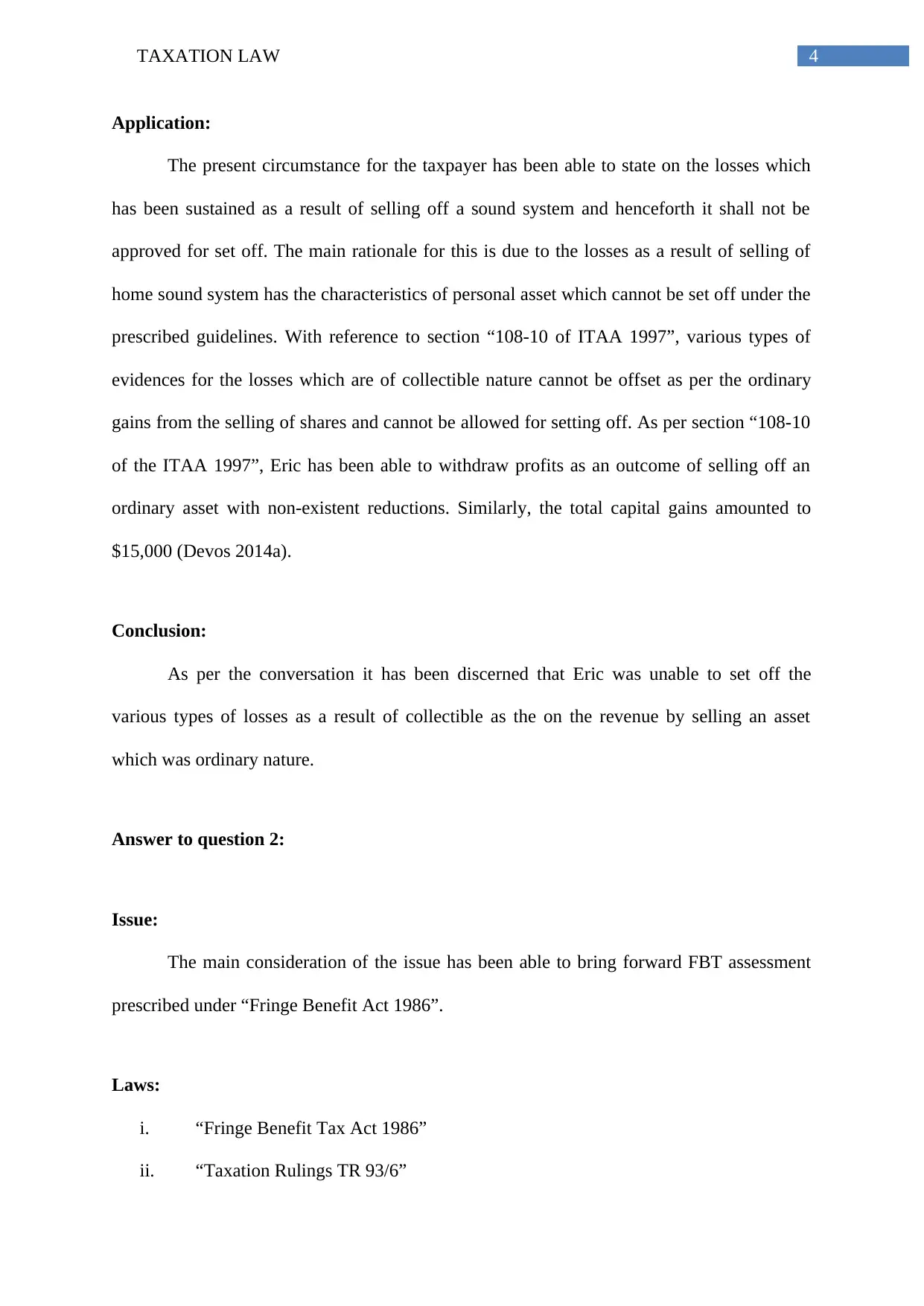
4TAXATION LAW
Application:
The present circumstance for the taxpayer has been able to state on the losses which
has been sustained as a result of selling off a sound system and henceforth it shall not be
approved for set off. The main rationale for this is due to the losses as a result of selling of
home sound system has the characteristics of personal asset which cannot be set off under the
prescribed guidelines. With reference to section “108-10 of ITAA 1997”, various types of
evidences for the losses which are of collectible nature cannot be offset as per the ordinary
gains from the selling of shares and cannot be allowed for setting off. As per section “108-10
of the ITAA 1997”, Eric has been able to withdraw profits as an outcome of selling off an
ordinary asset with non-existent reductions. Similarly, the total capital gains amounted to
$15,000 (Devos 2014a).
Conclusion:
As per the conversation it has been discerned that Eric was unable to set off the
various types of losses as a result of collectible as the on the revenue by selling an asset
which was ordinary nature.
Answer to question 2:
Issue:
The main consideration of the issue has been able to bring forward FBT assessment
prescribed under “Fringe Benefit Act 1986”.
Laws:
i. “Fringe Benefit Tax Act 1986”
ii. “Taxation Rulings TR 93/6”
Application:
The present circumstance for the taxpayer has been able to state on the losses which
has been sustained as a result of selling off a sound system and henceforth it shall not be
approved for set off. The main rationale for this is due to the losses as a result of selling of
home sound system has the characteristics of personal asset which cannot be set off under the
prescribed guidelines. With reference to section “108-10 of ITAA 1997”, various types of
evidences for the losses which are of collectible nature cannot be offset as per the ordinary
gains from the selling of shares and cannot be allowed for setting off. As per section “108-10
of the ITAA 1997”, Eric has been able to withdraw profits as an outcome of selling off an
ordinary asset with non-existent reductions. Similarly, the total capital gains amounted to
$15,000 (Devos 2014a).
Conclusion:
As per the conversation it has been discerned that Eric was unable to set off the
various types of losses as a result of collectible as the on the revenue by selling an asset
which was ordinary nature.
Answer to question 2:
Issue:
The main consideration of the issue has been able to bring forward FBT assessment
prescribed under “Fringe Benefit Act 1986”.
Laws:
i. “Fringe Benefit Tax Act 1986”
ii. “Taxation Rulings TR 93/6”
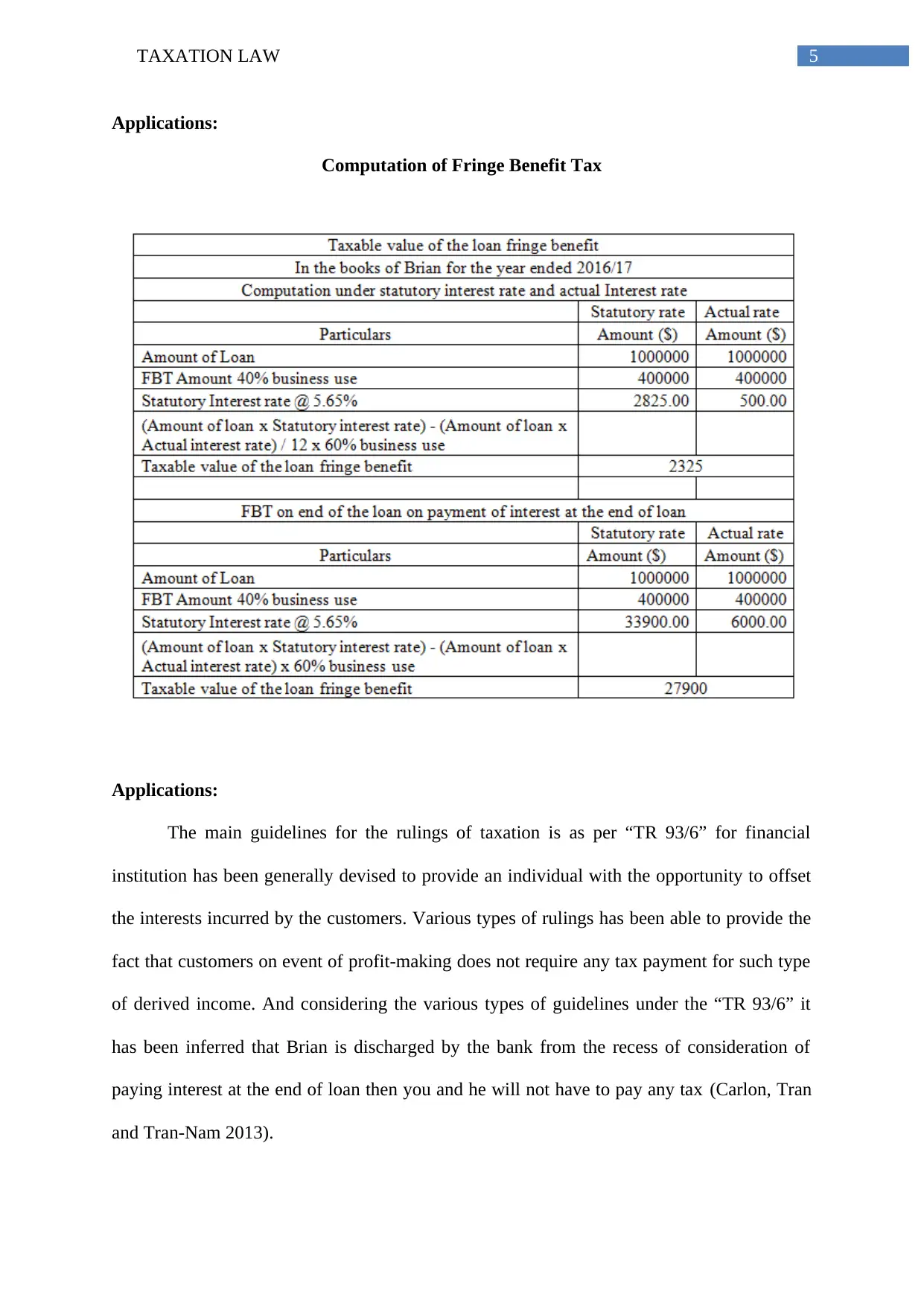
5TAXATION LAW
Applications:
Computation of Fringe Benefit Tax
Applications:
The main guidelines for the rulings of taxation is as per “TR 93/6” for financial
institution has been generally devised to provide an individual with the opportunity to offset
the interests incurred by the customers. Various types of rulings has been able to provide the
fact that customers on event of profit-making does not require any tax payment for such type
of derived income. And considering the various types of guidelines under the “TR 93/6” it
has been inferred that Brian is discharged by the bank from the recess of consideration of
paying interest at the end of loan then you and he will not have to pay any tax (Carlon, Tran
and Tran-Nam 2013).
Applications:
Computation of Fringe Benefit Tax
Applications:
The main guidelines for the rulings of taxation is as per “TR 93/6” for financial
institution has been generally devised to provide an individual with the opportunity to offset
the interests incurred by the customers. Various types of rulings has been able to provide the
fact that customers on event of profit-making does not require any tax payment for such type
of derived income. And considering the various types of guidelines under the “TR 93/6” it
has been inferred that Brian is discharged by the bank from the recess of consideration of
paying interest at the end of loan then you and he will not have to pay any tax (Carlon, Tran
and Tran-Nam 2013).
⊘ This is a preview!⊘
Do you want full access?
Subscribe today to unlock all pages.

Trusted by 1+ million students worldwide
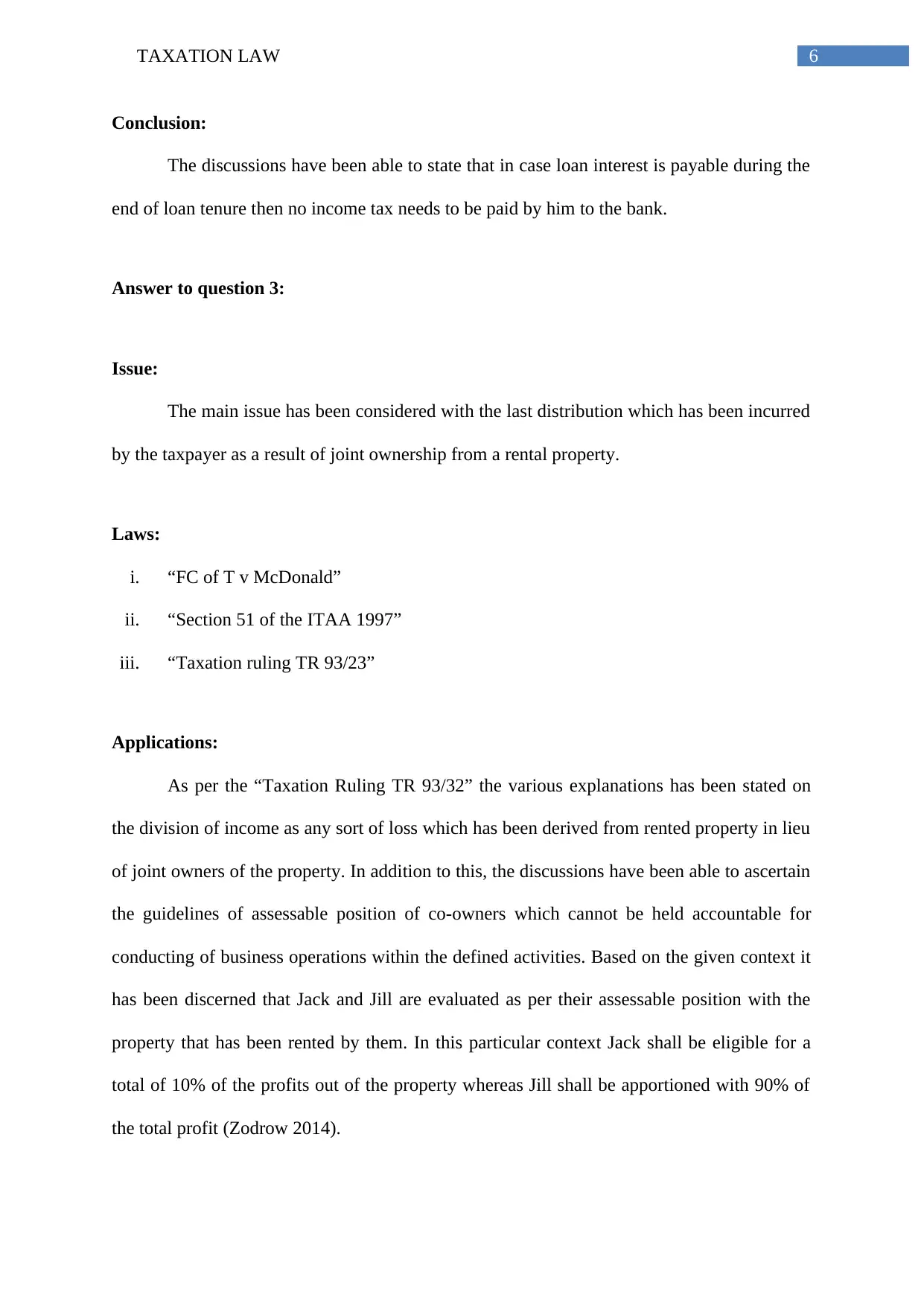
6TAXATION LAW
Conclusion:
The discussions have been able to state that in case loan interest is payable during the
end of loan tenure then no income tax needs to be paid by him to the bank.
Answer to question 3:
Issue:
The main issue has been considered with the last distribution which has been incurred
by the taxpayer as a result of joint ownership from a rental property.
Laws:
i. “FC of T v McDonald”
ii. “Section 51 of the ITAA 1997”
iii. “Taxation ruling TR 93/23”
Applications:
As per the “Taxation Ruling TR 93/32” the various explanations has been stated on
the division of income as any sort of loss which has been derived from rented property in lieu
of joint owners of the property. In addition to this, the discussions have been able to ascertain
the guidelines of assessable position of co-owners which cannot be held accountable for
conducting of business operations within the defined activities. Based on the given context it
has been discerned that Jack and Jill are evaluated as per their assessable position with the
property that has been rented by them. In this particular context Jack shall be eligible for a
total of 10% of the profits out of the property whereas Jill shall be apportioned with 90% of
the total profit (Zodrow 2014).
Conclusion:
The discussions have been able to state that in case loan interest is payable during the
end of loan tenure then no income tax needs to be paid by him to the bank.
Answer to question 3:
Issue:
The main issue has been considered with the last distribution which has been incurred
by the taxpayer as a result of joint ownership from a rental property.
Laws:
i. “FC of T v McDonald”
ii. “Section 51 of the ITAA 1997”
iii. “Taxation ruling TR 93/23”
Applications:
As per the “Taxation Ruling TR 93/32” the various explanations has been stated on
the division of income as any sort of loss which has been derived from rented property in lieu
of joint owners of the property. In addition to this, the discussions have been able to ascertain
the guidelines of assessable position of co-owners which cannot be held accountable for
conducting of business operations within the defined activities. Based on the given context it
has been discerned that Jack and Jill are evaluated as per their assessable position with the
property that has been rented by them. In this particular context Jack shall be eligible for a
total of 10% of the profits out of the property whereas Jill shall be apportioned with 90% of
the total profit (Zodrow 2014).
Paraphrase This Document
Need a fresh take? Get an instant paraphrase of this document with our AI Paraphraser
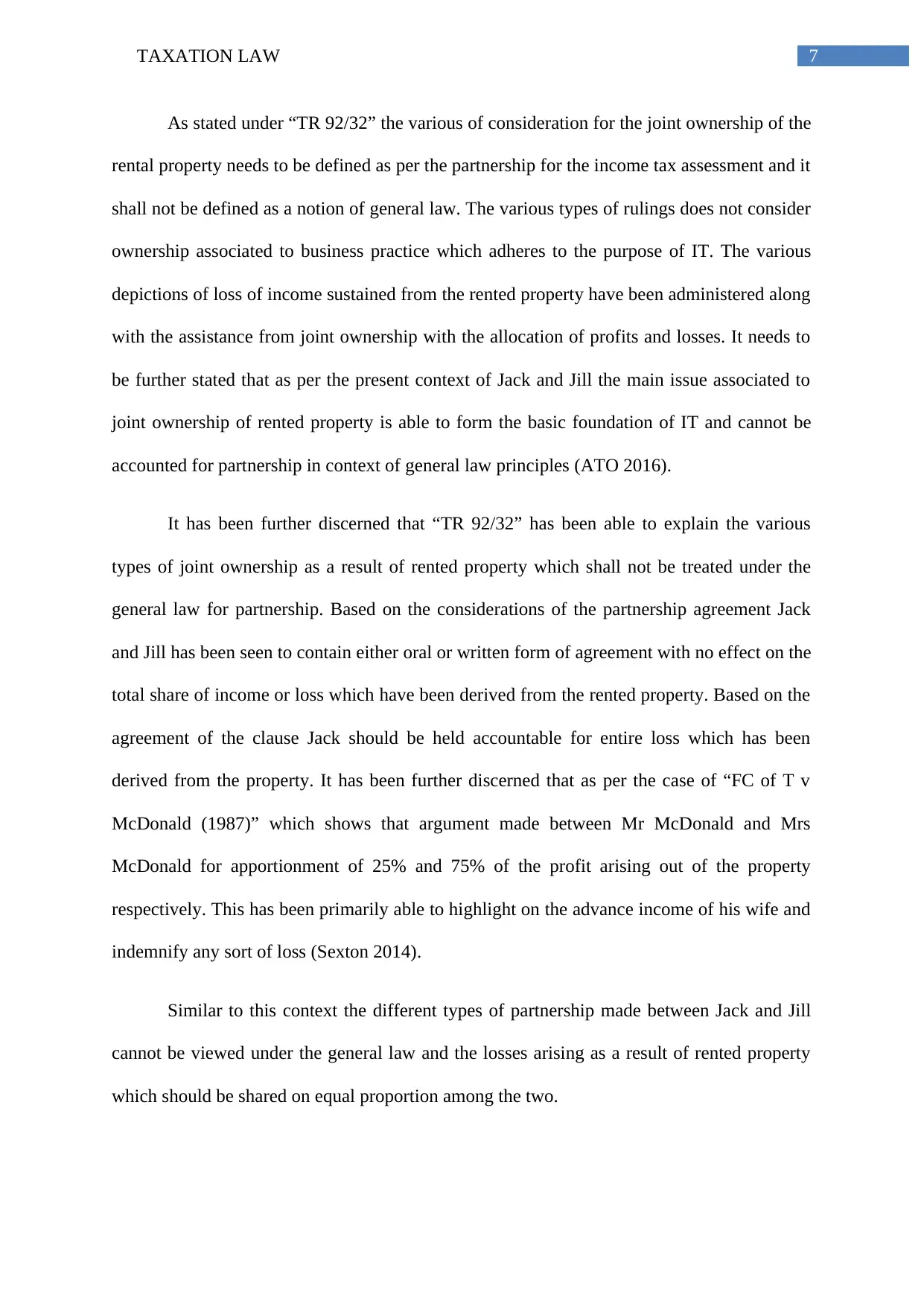
7TAXATION LAW
As stated under “TR 92/32” the various of consideration for the joint ownership of the
rental property needs to be defined as per the partnership for the income tax assessment and it
shall not be defined as a notion of general law. The various types of rulings does not consider
ownership associated to business practice which adheres to the purpose of IT. The various
depictions of loss of income sustained from the rented property have been administered along
with the assistance from joint ownership with the allocation of profits and losses. It needs to
be further stated that as per the present context of Jack and Jill the main issue associated to
joint ownership of rented property is able to form the basic foundation of IT and cannot be
accounted for partnership in context of general law principles (ATO 2016).
It has been further discerned that “TR 92/32” has been able to explain the various
types of joint ownership as a result of rented property which shall not be treated under the
general law for partnership. Based on the considerations of the partnership agreement Jack
and Jill has been seen to contain either oral or written form of agreement with no effect on the
total share of income or loss which have been derived from the rented property. Based on the
agreement of the clause Jack should be held accountable for entire loss which has been
derived from the property. It has been further discerned that as per the case of “FC of T v
McDonald (1987)” which shows that argument made between Mr McDonald and Mrs
McDonald for apportionment of 25% and 75% of the profit arising out of the property
respectively. This has been primarily able to highlight on the advance income of his wife and
indemnify any sort of loss (Sexton 2014).
Similar to this context the different types of partnership made between Jack and Jill
cannot be viewed under the general law and the losses arising as a result of rented property
which should be shared on equal proportion among the two.
As stated under “TR 92/32” the various of consideration for the joint ownership of the
rental property needs to be defined as per the partnership for the income tax assessment and it
shall not be defined as a notion of general law. The various types of rulings does not consider
ownership associated to business practice which adheres to the purpose of IT. The various
depictions of loss of income sustained from the rented property have been administered along
with the assistance from joint ownership with the allocation of profits and losses. It needs to
be further stated that as per the present context of Jack and Jill the main issue associated to
joint ownership of rented property is able to form the basic foundation of IT and cannot be
accounted for partnership in context of general law principles (ATO 2016).
It has been further discerned that “TR 92/32” has been able to explain the various
types of joint ownership as a result of rented property which shall not be treated under the
general law for partnership. Based on the considerations of the partnership agreement Jack
and Jill has been seen to contain either oral or written form of agreement with no effect on the
total share of income or loss which have been derived from the rented property. Based on the
agreement of the clause Jack should be held accountable for entire loss which has been
derived from the property. It has been further discerned that as per the case of “FC of T v
McDonald (1987)” which shows that argument made between Mr McDonald and Mrs
McDonald for apportionment of 25% and 75% of the profit arising out of the property
respectively. This has been primarily able to highlight on the advance income of his wife and
indemnify any sort of loss (Sexton 2014).
Similar to this context the different types of partnership made between Jack and Jill
cannot be viewed under the general law and the losses arising as a result of rented property
which should be shared on equal proportion among the two.
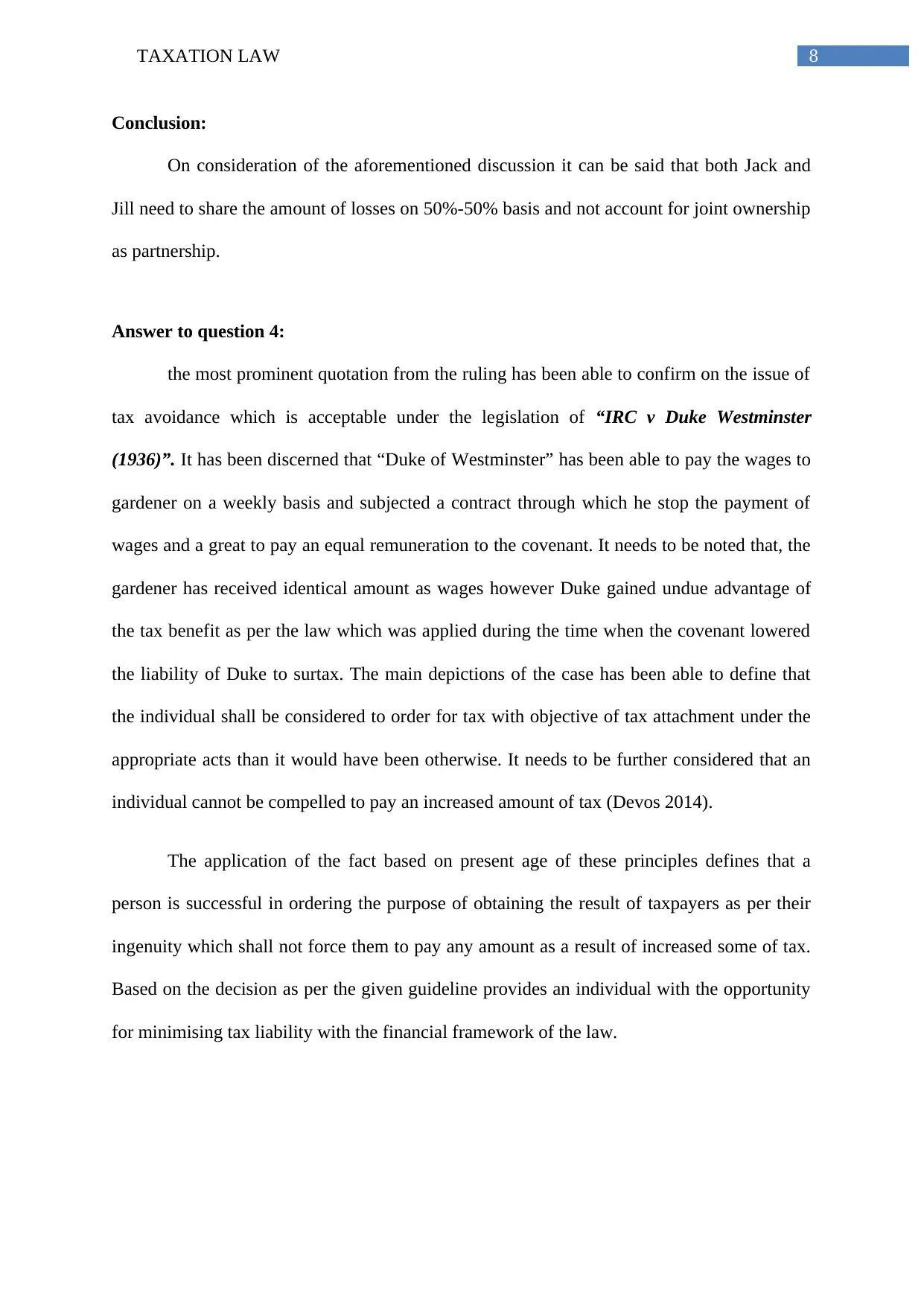
8TAXATION LAW
Conclusion:
On consideration of the aforementioned discussion it can be said that both Jack and
Jill need to share the amount of losses on 50%-50% basis and not account for joint ownership
as partnership.
Answer to question 4:
the most prominent quotation from the ruling has been able to confirm on the issue of
tax avoidance which is acceptable under the legislation of “IRC v Duke Westminster
(1936)”. It has been discerned that “Duke of Westminster” has been able to pay the wages to
gardener on a weekly basis and subjected a contract through which he stop the payment of
wages and a great to pay an equal remuneration to the covenant. It needs to be noted that, the
gardener has received identical amount as wages however Duke gained undue advantage of
the tax benefit as per the law which was applied during the time when the covenant lowered
the liability of Duke to surtax. The main depictions of the case has been able to define that
the individual shall be considered to order for tax with objective of tax attachment under the
appropriate acts than it would have been otherwise. It needs to be further considered that an
individual cannot be compelled to pay an increased amount of tax (Devos 2014).
The application of the fact based on present age of these principles defines that a
person is successful in ordering the purpose of obtaining the result of taxpayers as per their
ingenuity which shall not force them to pay any amount as a result of increased some of tax.
Based on the decision as per the given guideline provides an individual with the opportunity
for minimising tax liability with the financial framework of the law.
Conclusion:
On consideration of the aforementioned discussion it can be said that both Jack and
Jill need to share the amount of losses on 50%-50% basis and not account for joint ownership
as partnership.
Answer to question 4:
the most prominent quotation from the ruling has been able to confirm on the issue of
tax avoidance which is acceptable under the legislation of “IRC v Duke Westminster
(1936)”. It has been discerned that “Duke of Westminster” has been able to pay the wages to
gardener on a weekly basis and subjected a contract through which he stop the payment of
wages and a great to pay an equal remuneration to the covenant. It needs to be noted that, the
gardener has received identical amount as wages however Duke gained undue advantage of
the tax benefit as per the law which was applied during the time when the covenant lowered
the liability of Duke to surtax. The main depictions of the case has been able to define that
the individual shall be considered to order for tax with objective of tax attachment under the
appropriate acts than it would have been otherwise. It needs to be further considered that an
individual cannot be compelled to pay an increased amount of tax (Devos 2014).
The application of the fact based on present age of these principles defines that a
person is successful in ordering the purpose of obtaining the result of taxpayers as per their
ingenuity which shall not force them to pay any amount as a result of increased some of tax.
Based on the decision as per the given guideline provides an individual with the opportunity
for minimising tax liability with the financial framework of the law.
⊘ This is a preview!⊘
Do you want full access?
Subscribe today to unlock all pages.

Trusted by 1+ million students worldwide
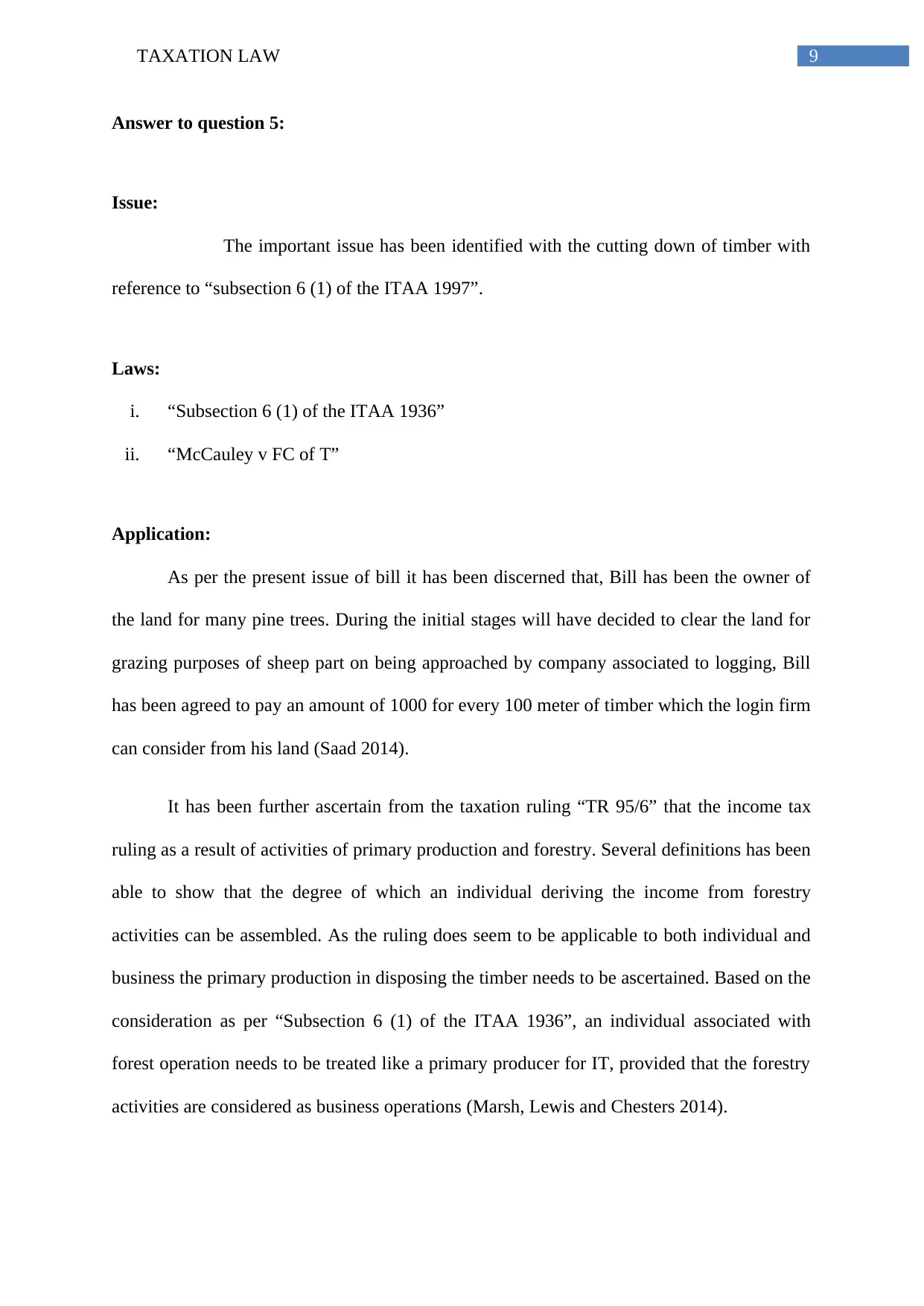
9TAXATION LAW
Answer to question 5:
Issue:
The important issue has been identified with the cutting down of timber with
reference to “subsection 6 (1) of the ITAA 1997”.
Laws:
i. “Subsection 6 (1) of the ITAA 1936”
ii. “McCauley v FC of T”
Application:
As per the present issue of bill it has been discerned that, Bill has been the owner of
the land for many pine trees. During the initial stages will have decided to clear the land for
grazing purposes of sheep part on being approached by company associated to logging, Bill
has been agreed to pay an amount of 1000 for every 100 meter of timber which the login firm
can consider from his land (Saad 2014).
It has been further ascertain from the taxation ruling “TR 95/6” that the income tax
ruling as a result of activities of primary production and forestry. Several definitions has been
able to show that the degree of which an individual deriving the income from forestry
activities can be assembled. As the ruling does seem to be applicable to both individual and
business the primary production in disposing the timber needs to be ascertained. Based on the
consideration as per “Subsection 6 (1) of the ITAA 1936”, an individual associated with
forest operation needs to be treated like a primary producer for IT, provided that the forestry
activities are considered as business operations (Marsh, Lewis and Chesters 2014).
Answer to question 5:
Issue:
The important issue has been identified with the cutting down of timber with
reference to “subsection 6 (1) of the ITAA 1997”.
Laws:
i. “Subsection 6 (1) of the ITAA 1936”
ii. “McCauley v FC of T”
Application:
As per the present issue of bill it has been discerned that, Bill has been the owner of
the land for many pine trees. During the initial stages will have decided to clear the land for
grazing purposes of sheep part on being approached by company associated to logging, Bill
has been agreed to pay an amount of 1000 for every 100 meter of timber which the login firm
can consider from his land (Saad 2014).
It has been further ascertain from the taxation ruling “TR 95/6” that the income tax
ruling as a result of activities of primary production and forestry. Several definitions has been
able to show that the degree of which an individual deriving the income from forestry
activities can be assembled. As the ruling does seem to be applicable to both individual and
business the primary production in disposing the timber needs to be ascertained. Based on the
consideration as per “Subsection 6 (1) of the ITAA 1936”, an individual associated with
forest operation needs to be treated like a primary producer for IT, provided that the forestry
activities are considered as business operations (Marsh, Lewis and Chesters 2014).
Paraphrase This Document
Need a fresh take? Get an instant paraphrase of this document with our AI Paraphraser
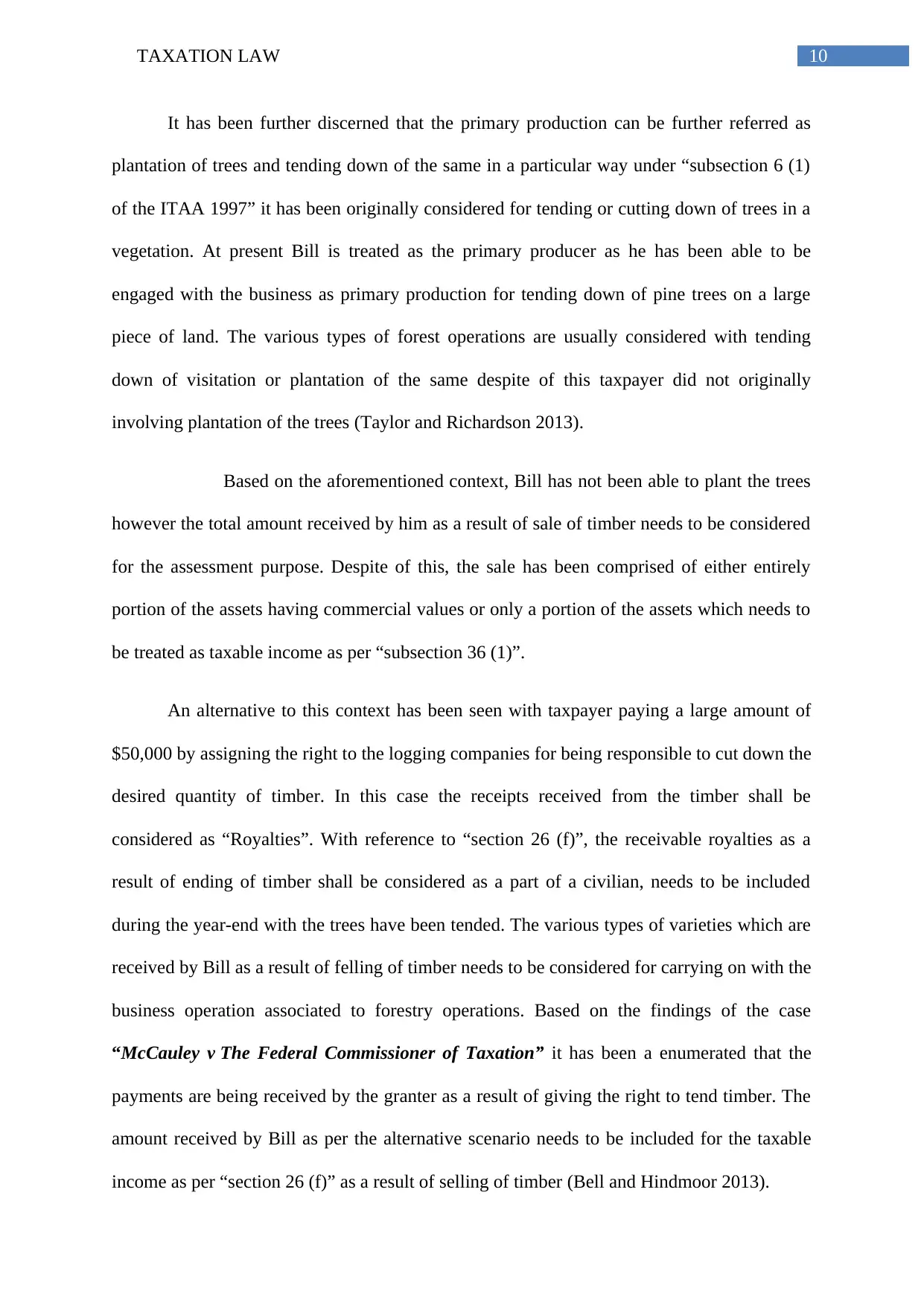
10TAXATION LAW
It has been further discerned that the primary production can be further referred as
plantation of trees and tending down of the same in a particular way under “subsection 6 (1)
of the ITAA 1997” it has been originally considered for tending or cutting down of trees in a
vegetation. At present Bill is treated as the primary producer as he has been able to be
engaged with the business as primary production for tending down of pine trees on a large
piece of land. The various types of forest operations are usually considered with tending
down of visitation or plantation of the same despite of this taxpayer did not originally
involving plantation of the trees (Taylor and Richardson 2013).
Based on the aforementioned context, Bill has not been able to plant the trees
however the total amount received by him as a result of sale of timber needs to be considered
for the assessment purpose. Despite of this, the sale has been comprised of either entirely
portion of the assets having commercial values or only a portion of the assets which needs to
be treated as taxable income as per “subsection 36 (1)”.
An alternative to this context has been seen with taxpayer paying a large amount of
$50,000 by assigning the right to the logging companies for being responsible to cut down the
desired quantity of timber. In this case the receipts received from the timber shall be
considered as “Royalties”. With reference to “section 26 (f)”, the receivable royalties as a
result of ending of timber shall be considered as a part of a civilian, needs to be included
during the year-end with the trees have been tended. The various types of varieties which are
received by Bill as a result of felling of timber needs to be considered for carrying on with the
business operation associated to forestry operations. Based on the findings of the case
“McCauley v The Federal Commissioner of Taxation” it has been a enumerated that the
payments are being received by the granter as a result of giving the right to tend timber. The
amount received by Bill as per the alternative scenario needs to be included for the taxable
income as per “section 26 (f)” as a result of selling of timber (Bell and Hindmoor 2013).
It has been further discerned that the primary production can be further referred as
plantation of trees and tending down of the same in a particular way under “subsection 6 (1)
of the ITAA 1997” it has been originally considered for tending or cutting down of trees in a
vegetation. At present Bill is treated as the primary producer as he has been able to be
engaged with the business as primary production for tending down of pine trees on a large
piece of land. The various types of forest operations are usually considered with tending
down of visitation or plantation of the same despite of this taxpayer did not originally
involving plantation of the trees (Taylor and Richardson 2013).
Based on the aforementioned context, Bill has not been able to plant the trees
however the total amount received by him as a result of sale of timber needs to be considered
for the assessment purpose. Despite of this, the sale has been comprised of either entirely
portion of the assets having commercial values or only a portion of the assets which needs to
be treated as taxable income as per “subsection 36 (1)”.
An alternative to this context has been seen with taxpayer paying a large amount of
$50,000 by assigning the right to the logging companies for being responsible to cut down the
desired quantity of timber. In this case the receipts received from the timber shall be
considered as “Royalties”. With reference to “section 26 (f)”, the receivable royalties as a
result of ending of timber shall be considered as a part of a civilian, needs to be included
during the year-end with the trees have been tended. The various types of varieties which are
received by Bill as a result of felling of timber needs to be considered for carrying on with the
business operation associated to forestry operations. Based on the findings of the case
“McCauley v The Federal Commissioner of Taxation” it has been a enumerated that the
payments are being received by the granter as a result of giving the right to tend timber. The
amount received by Bill as per the alternative scenario needs to be included for the taxable
income as per “section 26 (f)” as a result of selling of timber (Bell and Hindmoor 2013).
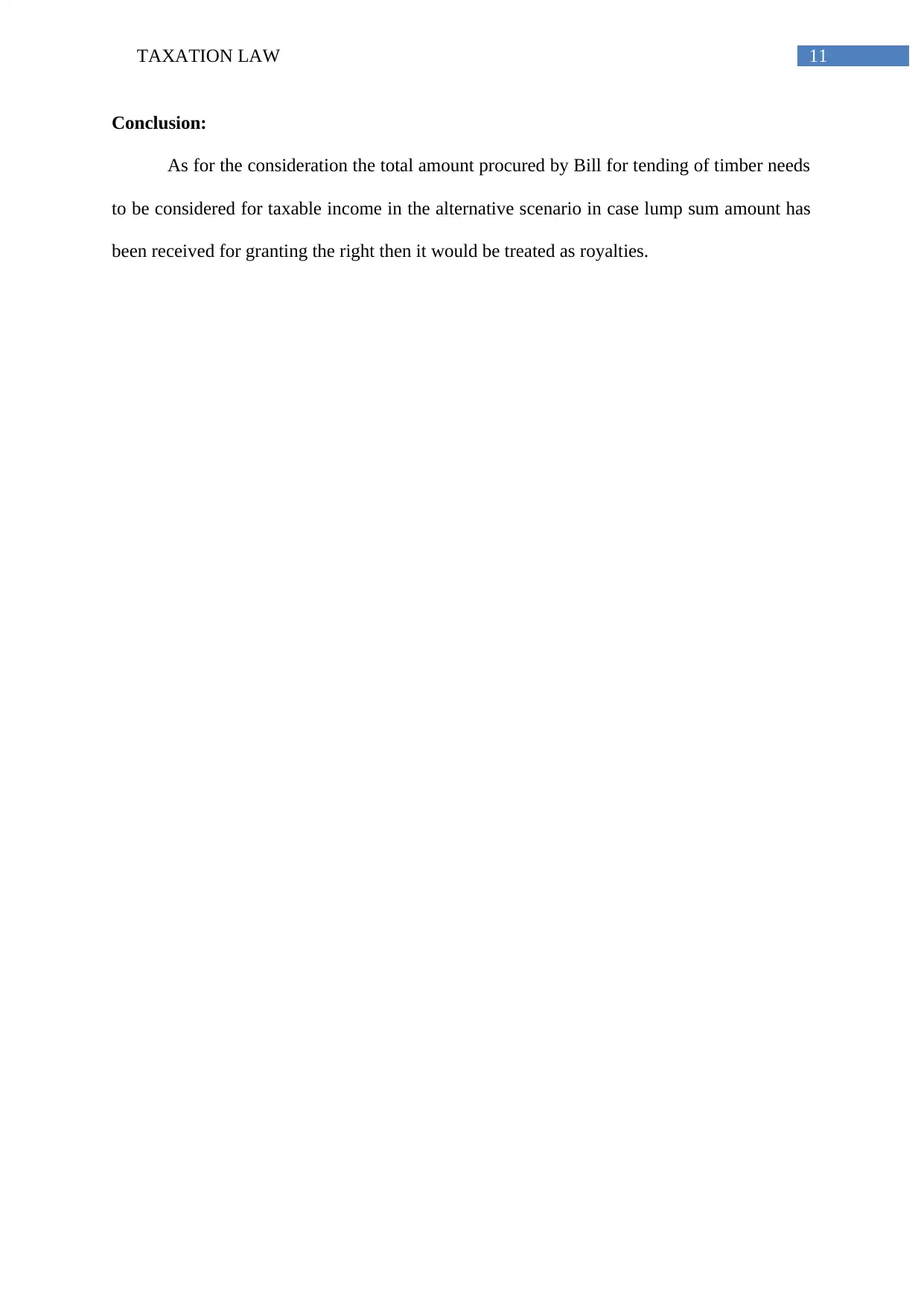
11TAXATION LAW
Conclusion:
As for the consideration the total amount procured by Bill for tending of timber needs
to be considered for taxable income in the alternative scenario in case lump sum amount has
been received for granting the right then it would be treated as royalties.
Conclusion:
As for the consideration the total amount procured by Bill for tending of timber needs
to be considered for taxable income in the alternative scenario in case lump sum amount has
been received for granting the right then it would be treated as royalties.
⊘ This is a preview!⊘
Do you want full access?
Subscribe today to unlock all pages.

Trusted by 1+ million students worldwide
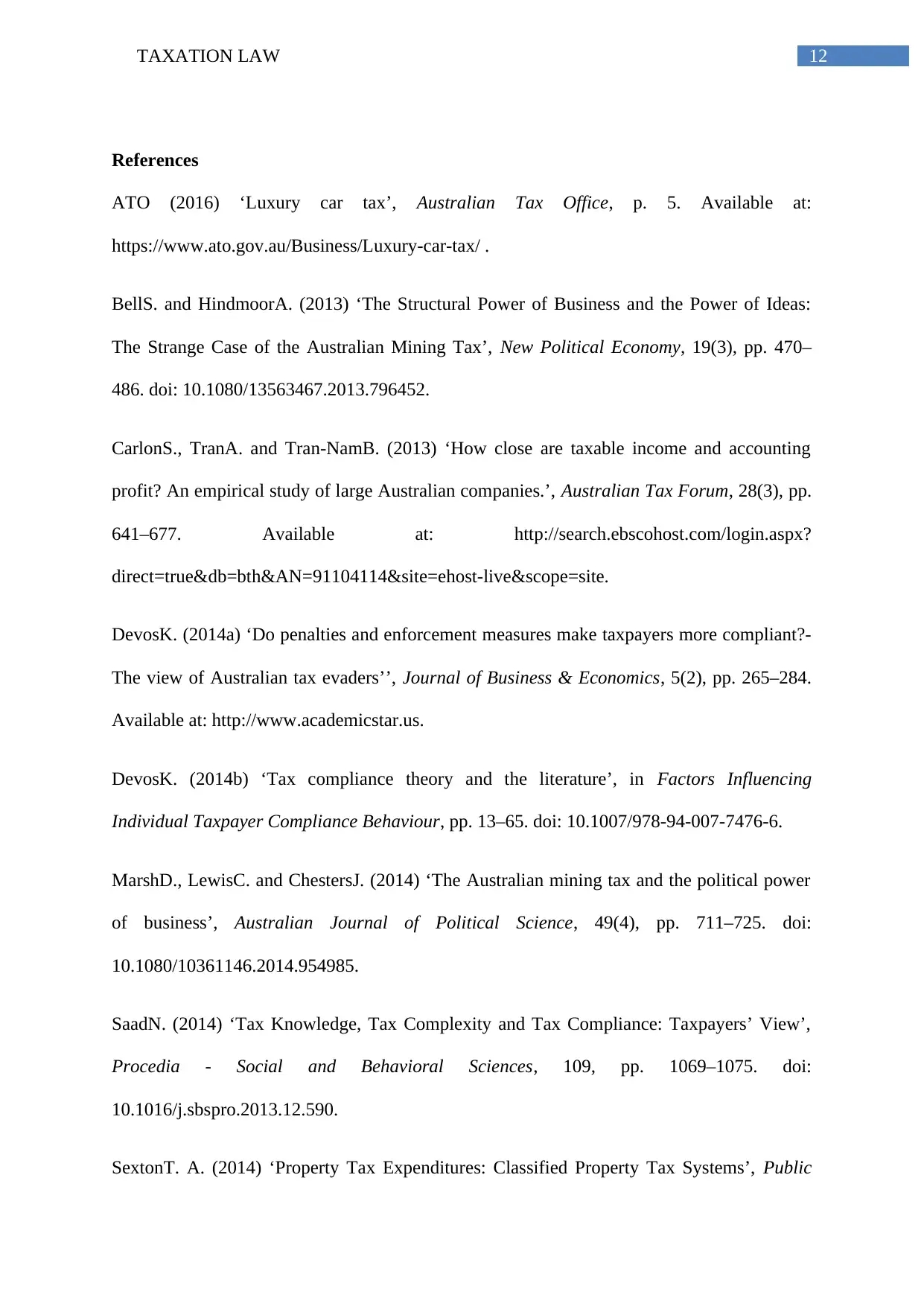
12TAXATION LAW
References
ATO (2016) ‘Luxury car tax’, Australian Tax Office, p. 5. Available at:
https://www.ato.gov.au/Business/Luxury-car-tax/ .
BellS. and HindmoorA. (2013) ‘The Structural Power of Business and the Power of Ideas:
The Strange Case of the Australian Mining Tax’, New Political Economy, 19(3), pp. 470–
486. doi: 10.1080/13563467.2013.796452.
CarlonS., TranA. and Tran-NamB. (2013) ‘How close are taxable income and accounting
profit? An empirical study of large Australian companies.’, Australian Tax Forum, 28(3), pp.
641–677. Available at: http://search.ebscohost.com/login.aspx?
direct=true&db=bth&AN=91104114&site=ehost-live&scope=site.
DevosK. (2014a) ‘Do penalties and enforcement measures make taxpayers more compliant?-
The view of Australian tax evaders’’, Journal of Business & Economics, 5(2), pp. 265–284.
Available at: http://www.academicstar.us.
DevosK. (2014b) ‘Tax compliance theory and the literature’, in Factors Influencing
Individual Taxpayer Compliance Behaviour, pp. 13–65. doi: 10.1007/978-94-007-7476-6.
MarshD., LewisC. and ChestersJ. (2014) ‘The Australian mining tax and the political power
of business’, Australian Journal of Political Science, 49(4), pp. 711–725. doi:
10.1080/10361146.2014.954985.
SaadN. (2014) ‘Tax Knowledge, Tax Complexity and Tax Compliance: Taxpayers’ View’,
Procedia - Social and Behavioral Sciences, 109, pp. 1069–1075. doi:
10.1016/j.sbspro.2013.12.590.
SextonT. A. (2014) ‘Property Tax Expenditures: Classified Property Tax Systems’, Public
References
ATO (2016) ‘Luxury car tax’, Australian Tax Office, p. 5. Available at:
https://www.ato.gov.au/Business/Luxury-car-tax/ .
BellS. and HindmoorA. (2013) ‘The Structural Power of Business and the Power of Ideas:
The Strange Case of the Australian Mining Tax’, New Political Economy, 19(3), pp. 470–
486. doi: 10.1080/13563467.2013.796452.
CarlonS., TranA. and Tran-NamB. (2013) ‘How close are taxable income and accounting
profit? An empirical study of large Australian companies.’, Australian Tax Forum, 28(3), pp.
641–677. Available at: http://search.ebscohost.com/login.aspx?
direct=true&db=bth&AN=91104114&site=ehost-live&scope=site.
DevosK. (2014a) ‘Do penalties and enforcement measures make taxpayers more compliant?-
The view of Australian tax evaders’’, Journal of Business & Economics, 5(2), pp. 265–284.
Available at: http://www.academicstar.us.
DevosK. (2014b) ‘Tax compliance theory and the literature’, in Factors Influencing
Individual Taxpayer Compliance Behaviour, pp. 13–65. doi: 10.1007/978-94-007-7476-6.
MarshD., LewisC. and ChestersJ. (2014) ‘The Australian mining tax and the political power
of business’, Australian Journal of Political Science, 49(4), pp. 711–725. doi:
10.1080/10361146.2014.954985.
SaadN. (2014) ‘Tax Knowledge, Tax Complexity and Tax Compliance: Taxpayers’ View’,
Procedia - Social and Behavioral Sciences, 109, pp. 1069–1075. doi:
10.1016/j.sbspro.2013.12.590.
SextonT. A. (2014) ‘Property Tax Expenditures: Classified Property Tax Systems’, Public
Paraphrase This Document
Need a fresh take? Get an instant paraphrase of this document with our AI Paraphraser
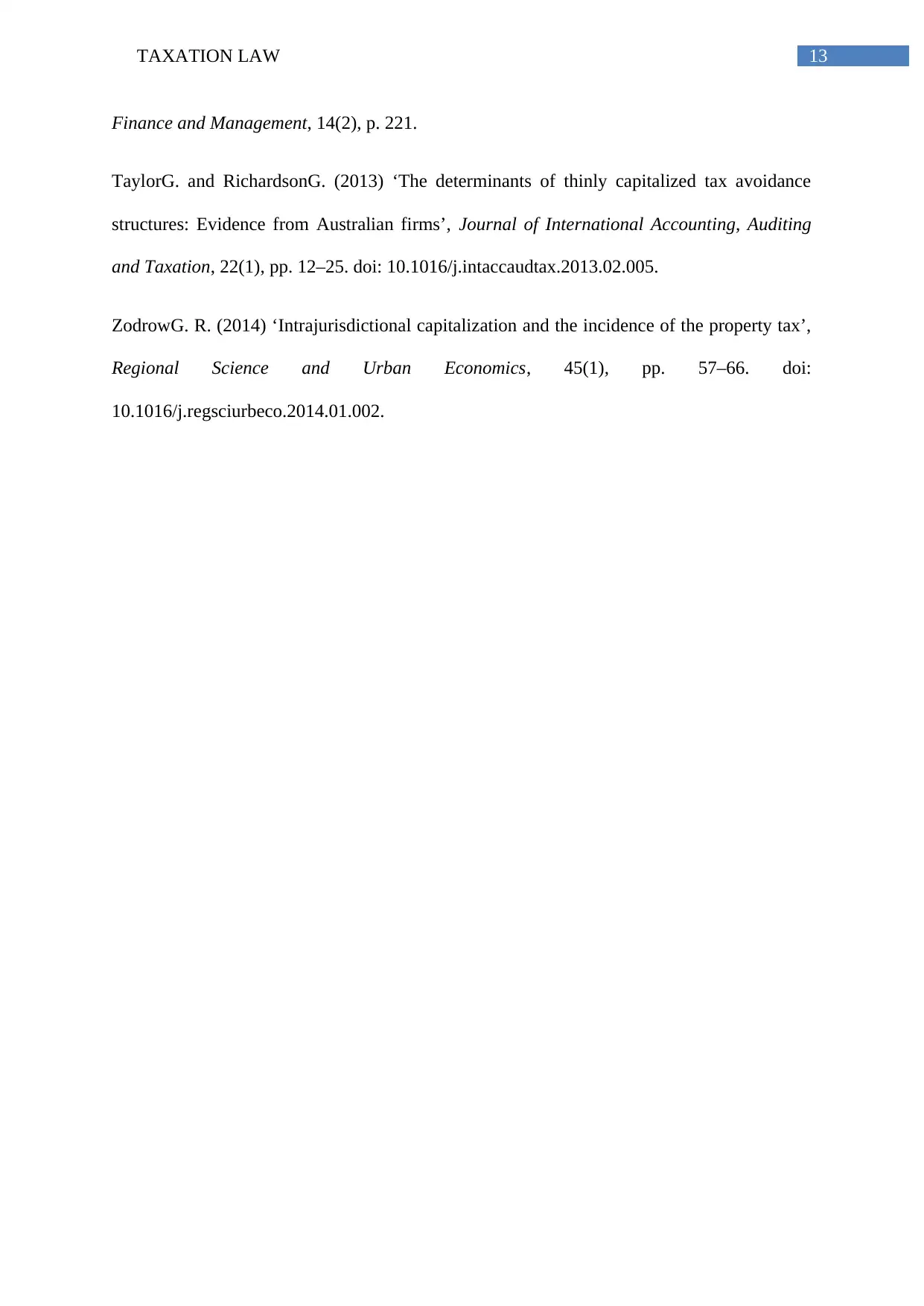
13TAXATION LAW
Finance and Management, 14(2), p. 221.
TaylorG. and RichardsonG. (2013) ‘The determinants of thinly capitalized tax avoidance
structures: Evidence from Australian firms’, Journal of International Accounting, Auditing
and Taxation, 22(1), pp. 12–25. doi: 10.1016/j.intaccaudtax.2013.02.005.
ZodrowG. R. (2014) ‘Intrajurisdictional capitalization and the incidence of the property tax’,
Regional Science and Urban Economics, 45(1), pp. 57–66. doi:
10.1016/j.regsciurbeco.2014.01.002.
Finance and Management, 14(2), p. 221.
TaylorG. and RichardsonG. (2013) ‘The determinants of thinly capitalized tax avoidance
structures: Evidence from Australian firms’, Journal of International Accounting, Auditing
and Taxation, 22(1), pp. 12–25. doi: 10.1016/j.intaccaudtax.2013.02.005.
ZodrowG. R. (2014) ‘Intrajurisdictional capitalization and the incidence of the property tax’,
Regional Science and Urban Economics, 45(1), pp. 57–66. doi:
10.1016/j.regsciurbeco.2014.01.002.
1 out of 14
Related Documents
Your All-in-One AI-Powered Toolkit for Academic Success.
+13062052269
info@desklib.com
Available 24*7 on WhatsApp / Email
![[object Object]](/_next/static/media/star-bottom.7253800d.svg)
Unlock your academic potential
© 2024 | Zucol Services PVT LTD | All rights reserved.





